Items filtered by date: November 2022
Foot Blisters From Running
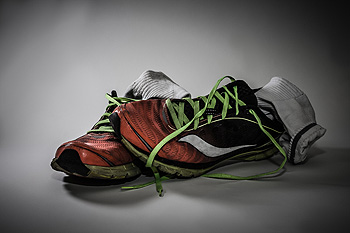
Runners can easily develop blisters on their toes, soles, insides of their feet, and heels. Blisters are liquid-filled pockets of skin that can develop on the feet from a combination of heat, friction, and sweat. Common causes of foot blisters are poorly fitting shoes, socks that do not sufficiently protect the feet, and sweaty feet. To prevent blisters while running, wear well-fitted shoes that do not allow the foot to rub against the inside of the shoe. Break in new running shoes slowly until you know they are comfortable. When purchasing running shoes, shop for them later in the day when feet are at their largest, and wear socks you plan to wear while running. Measure both feet and buy shoes that correspond to the biggest size foot. If inserts are needed, make sure to put them in the shoes you plan to buy so you know they fit well, and you will maintain comfort. Socks worn while running should be clean and made of breathable material. Compression socks can help with circulation, toe socks can reduce friction between toes, and padded socks can help cushion the foot during runs. If a blister develops, do not pop it. Cover it with an adhesive bandage and allow it to heal. If your blister persists or worsens, contact a podiatrist who can help with treatment and provide more ideas for prevention.
Blisters may appear as a single bubble or in a cluster. They can cause a lot of pain and may be filled with pus, blood, or watery serum. If your feet are hurting, contact one of our podiatrists of Sayville Foot Care. Our doctors can provide the care you need to keep you pain-free and on your feet.
Foot Blisters
Foot blisters are often the result of friction. This happens due to the constant rubbing from shoes, which can lead to pain.
What Are Foot Blisters?
A foot blister is a small fluid-filled pocket that forms on the upper-most layer of the skin. Blisters are filled with clear fluid and can lead to blood drainage or pus if the area becomes infected.
Symptoms
(Blister symptoms may vary depending on what is causing them)
- Bubble of skin filled with fluid
- Redness
- Moderate to severe pain
- Itching
Prevention & Treatment
In order to prevent blisters, you should be sure to wear comfortable shoes with socks that cushion your feet and absorb sweat. Breaking a blister open may increase your chances of developing an infection. However, if your blister breaks, you should wash the area with soap and water immediately and then apply a bandage to the affected area. If your blisters cause severe pain it is important that you call your podiatrist right away.
If you have any questions, please feel free to contact our office located in Sayville, NY . We offer the newest diagnostic and treatment technologies for all your foot care needs.
Arthritis Can Cause Pain in the Feet and Ankles
Ankle Sprains and Volleyball
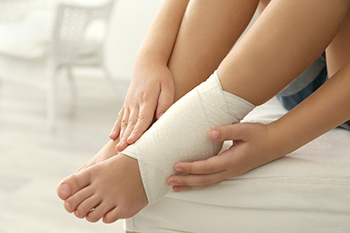
Sometimes, playing a particular kind of sport can increase an athlete’s susceptibility to particular kinds of foot conditions. For example, when an individual plays volleyball, they may be putting themselves at a risk of enduring a foot injury, such as an ankle sprain. The lateral ankle sprain is a common injury among volleyball players. There are several reasons for this. Most importantly, volleyball players often must frequently jump during games. When coming back down from a high jump, a volleyball player might land incorrectly on the outside of the foot. Often the force with which this occurs on the feet can be too much for the muscles around the ankle to handle. Ankle sprains can be the result. If you are a volleyball player and want to take steps to protect your feet, it is a good idea to contact a podiatrist today to schedule an appointment.
Ankle sprains are common but need immediate attention. If you need your feet checked, contact one of our podiatrists from Sayville Foot Care. Our doctors can provide the care you need to keep you pain-free and on your feet.
How Does an Ankle Sprain Occur?
Ankle sprains take place when the ligaments in your ankle are torn or stretched beyond their limits. There are multiple ways that the ankle can become injured, including twisting or rolling over onto your ankle, putting undue stress on it, or causing trauma to the ankle itself.
What Are the Symptoms?
- Mild to moderate bruising
- Limited mobility
- Swelling
- Discoloration of the skin (depending on severity)
Preventing a Sprain
- Wearing appropriate shoes for the occasion
- Stretching before exercises and sports
- Knowing your limits
Treatment of a Sprain
Treatment of a sprain depends on the severity. Many times, people are told to rest and remain off their feet completely, while others are given an air cast. If the sprain is very severe, surgery may be required.
If you have suffered an ankle sprain previously, you may want to consider additional support such as a brace and regular exercises to strengthen the ankle.
If you have any questions please feel free to contact our office located in Sayville, NY . We offer the newest diagnostic and treatment technologies for all your foot and ankle needs.
Why Are My Feet Swollen?
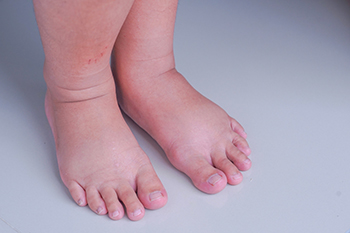
Swollen feet can be uncomfortable. The medical term is known as oedema, and it can happen for a variety of reasons. Pregnancy is a reason the feet can swell, and may become worse as the pregnancy progresses. This is a result of the excess fluid the body needs to support the growing fetus, and will gradually dissipate when the baby is born. Swollen feet may develop in patients who eat salty foods, and may be balanced in people who drink plenty of fresh water daily. Additionally, this condition may be caused by taking specific medications that can include blood pressure pills or antidepressants. Oedema can occur as an allergic reaction from an insect bite, or it may happen from an ankle sprain or fracture. These may be existing medical conditions that can lead to having swollen feet, consisting of a kidney disorder, or a heart condition. There are some patients who have found mild relief when they frequently elevate their feet, in addition to practicing gentle exercises and stretches. If you have swollen feet, please consult with a podiatrist who can offer you effective relief methods.
Swollen feet can be a sign of an underlying condition. If you have any concerns, contact one of our podiatrists of Sayville Foot Care. Our doctors can provide the care you need to keep you pain-free and on your feet.
Swollen feet are a common ailment among pregnant women and people who stand or sit for extended periods. Aging may increase the possibility of swollen feet and patients who are obese often notice when their feet are swelling too. There may be medical reasons why swollen feet occur:
- Phlebitis - A condition that causes the veins to become inflamed and can also cause leg pain.
- Liver disease - This may lead to low blood levels of albumin which is a protein. This can cause fluid in the blood to pass into the tissues and several areas of the body can become swollen.
- Heart failure - When the heart doesn’t pump properly the blood that is normally pumped back to the heart can pool in the veins of the legs causing swollen feet.
- Kidney disease - One of the main functions of the kidneys is releasing excess fluid in the body. This type of condition can make it difficult for the kidneys to function properly, and as a result the feet may become swollen.
- Deep-vein thrombosis (DVT)- This is a serious condition where blood clots form in the veins of the legs. They can block the return of blood from the legs to the heart which may cause the feet to swell. It is important to be treated by a podiatrist if this condition is present.
Swollen feet can also be caused by bone and tendon conditions, including fractures, arthritis, and tendinitis. Additionally, there may be skin and toenail conditions and an infection may cause the feet to swell. Patients who take medicine to treat high blood pressure may be prone to getting swollen feet.
Many patients elevate their feet to help relieve the swelling and this is generally a temporary remedy. When a podiatrist is consulted the reason behind the swelling can be uncovered and subsequently treated.
If you have any questions please feel free to contact our office located in Sayville, NY . We offer the newest diagnostic tools and technology to treat your foot and ankle needs.
How to Keep Babies Shoes on Their Feet
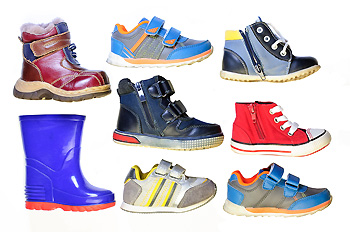
Many parents look forward to purchasing their baby's first pair of shoes. Prior to this enjoyable time, many parents have their babies crawl and walk barefoot, which is helpful in strengthening the entire foot. When it is time for your child to walk outside, they may like the sensation of feeling different surfaces on their feet, such as grass and sand. For rougher surfaces or inclement weather, shoes will need to be worn. Research has shown it is best for the first shoes to have non-slip soles and to be made with flexible materials. The fit should be perfect when the shoes are first tried on, and a break-in period is not needed. Many babies like to pull their shoes off, and there are various ways to avoid that. Firstly, it is important to make sure they fit correctly and are not too tight. Secondly, they may try to pull them off because they don’t like them, and parents need to make sure as best as they can that this is avoided. This may have to be done by testing various styles and colors before purchasing the shoes. If you have questions about what type of shoes to buy for your children, please confer with a podiatrist who can help you with any concerns you may have.
The health of a child’s feet is vital to their overall well-being. If you have any questions regarding foot health, contact one of our podiatrists of Sayville Foot Care. Our doctors can provide the care you need to keep you pain-free and on your feet.
Tips for Keeping Children's Feet Healthy
- Make sure their shoes fit properly
- Look for any signs of in-toeing or out-toeing
- Check to see if they have Clubfoot (condition that affects your child’s foot and ankle, twisting the heel and toes inward) which is one of the most common nonmajor birth defects.
- Lightly cover your baby’s feet (Tight covers may keep your baby from moving their feet freely, and could prevent normal development)
- Allow your toddler to go shoeless (Shoes can be restricting for a young child’s foot)
- Cut toenails straight across to avoid ingrown toenails
- Keep your child’s foot clean and dry
- Cover cuts and scrapes. Wash any scratches with soap and water and cover them with a bandage until they’ve healed.
If you have any questions, please feel free to contact our office located in Sayville, NY . We offer the newest diagnostic and treatment technologies for all your foot care needs.
How Does the Cuboid Bone Work?
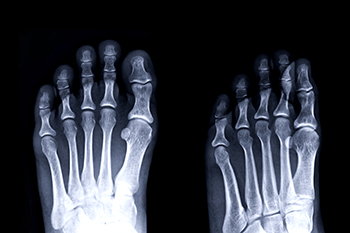
The feet are incredibly complex, intricate parts of the human body, made up of a number of different and important bones. Each bone serves a critical function, including the cuboid bone. One ought to know about this bone because it serves an important role in supporting the arch of the foot and providing stability. As the name of the bone suggests, it is shaped in a kind of cubical structure. This bone is located in the midfoot area and is situated essentially on the outer side of the foot. Being diligent in taking good care of the cuboid bone is essential to maintaining good foot health because if it moves out of alignment, a condition known as cuboid syndrome might develop. This foot affliction can cause a variety of symptoms, most notably a kind of pain on the outer side of the foot. This area of the foot is commonly referred to as the lateral area. For more information about this important bone in the foot, contact your podiatrist.
If you have any concerns about your feet, contact one of our podiatrists from Sayville Foot Care. Our doctors can provide the care you need to keep you pain-free and on your feet.
Biomechanics in Podiatry
Podiatric biomechanics is a particular sector of specialty podiatry with licensed practitioners who are trained to diagnose and treat conditions affecting the foot, ankle and lower leg. Biomechanics deals with the forces that act against the body, causing an interference with the biological structures. It focuses on the movement of the ankle, the foot and the forces that interact with them.
A History of Biomechanics
- Biomechanics dates back to the BC era in Egypt where evidence of professional foot care has been recorded.
- In 1974, biomechanics gained a higher profile from the studies of Merton Root, who claimed that by changing or controlling the forces between the ankle and the foot, corrections or conditions could be implemented to gain strength and coordination in the area.
Modern technological improvements are based on past theories and therapeutic processes that provide a better understanding of podiatric concepts for biomechanics. Computers can provide accurate information about the forces and patterns of the feet and lower legs.
Understanding biomechanics of the feet can help improve and eliminate pain, stopping further stress to the foot.
If you have any questions please feel free to contact our office located in Sayville, NY . We offer the newest diagnostic and treatment technologies for all your foot and ankle needs.

